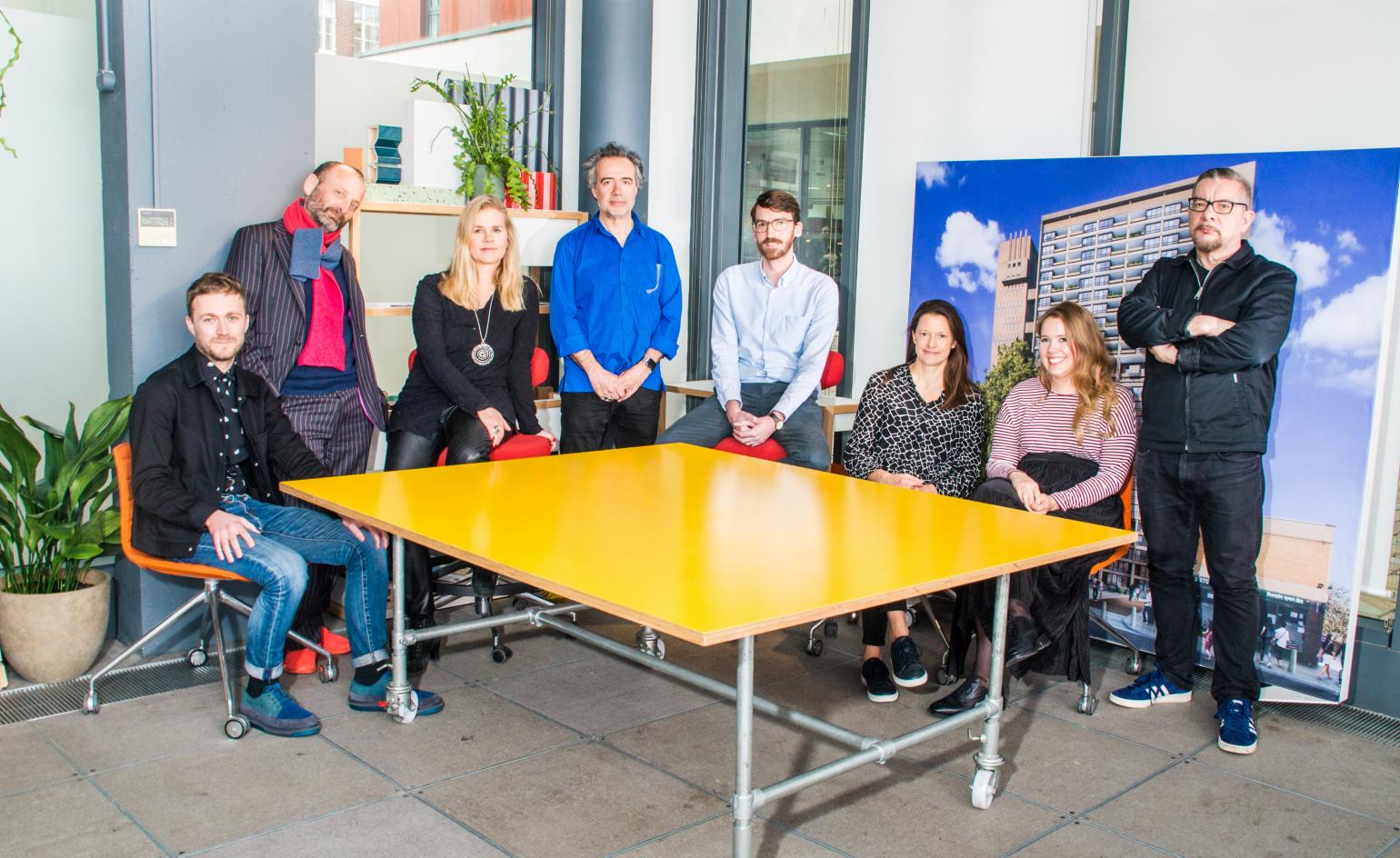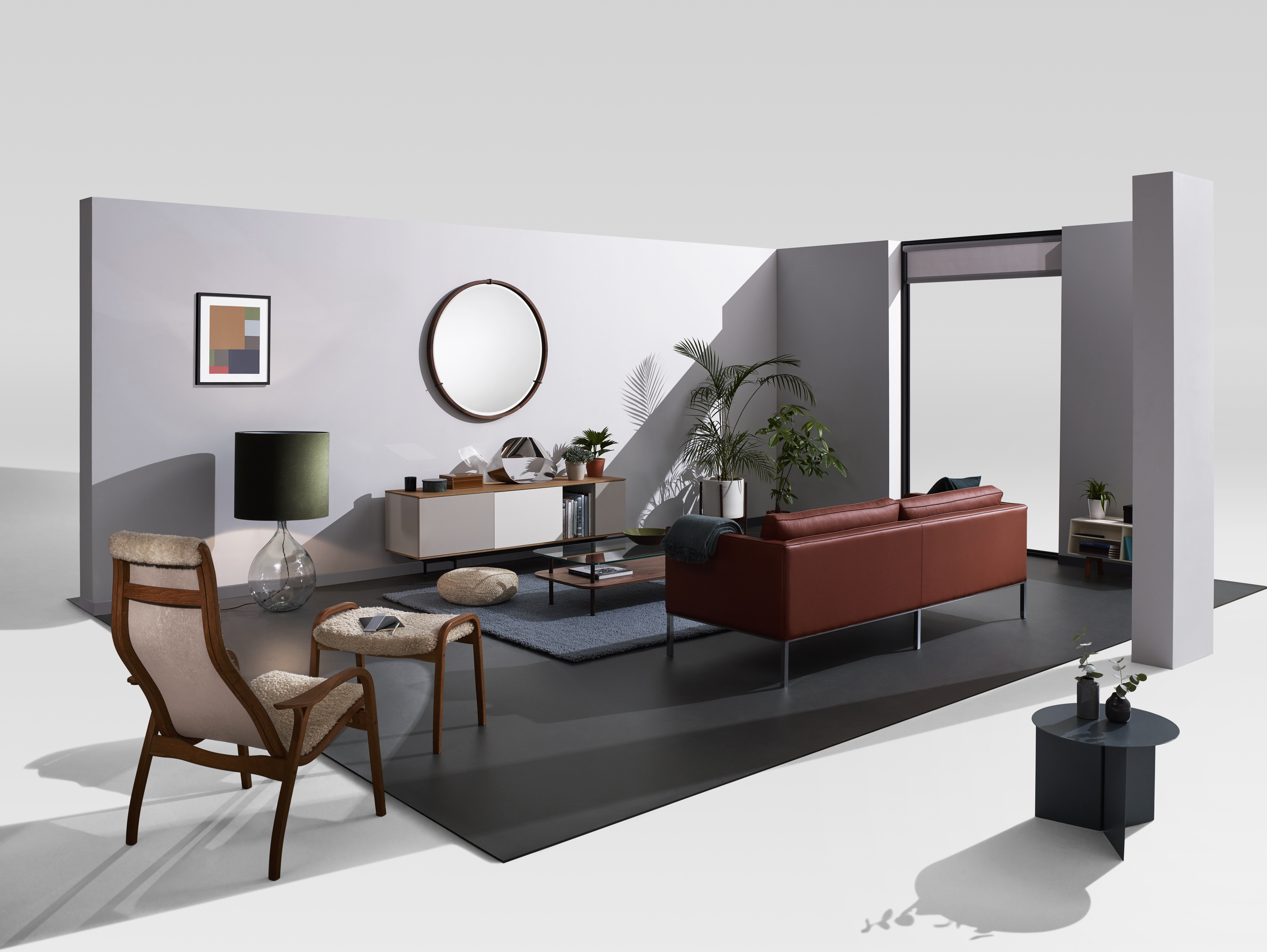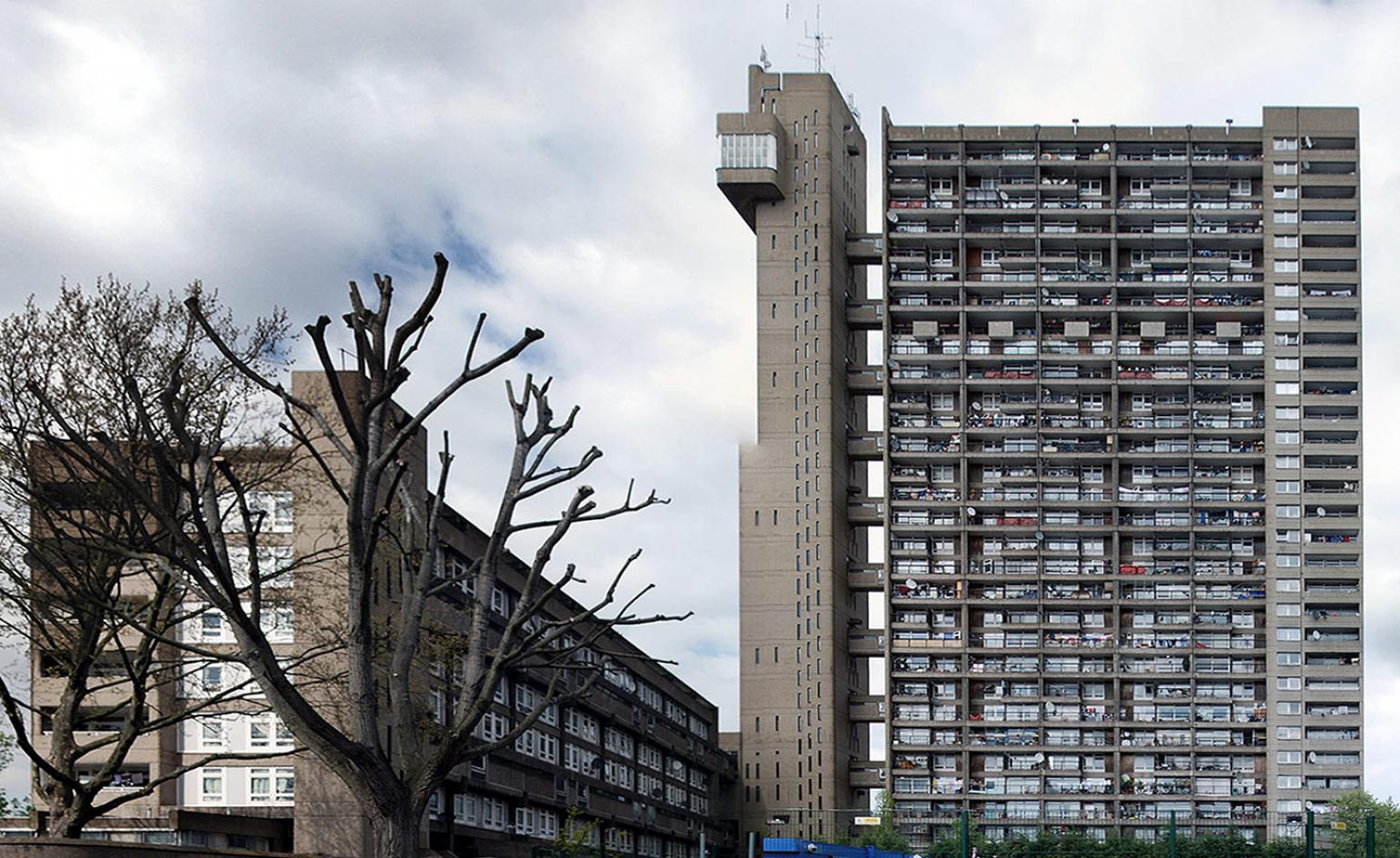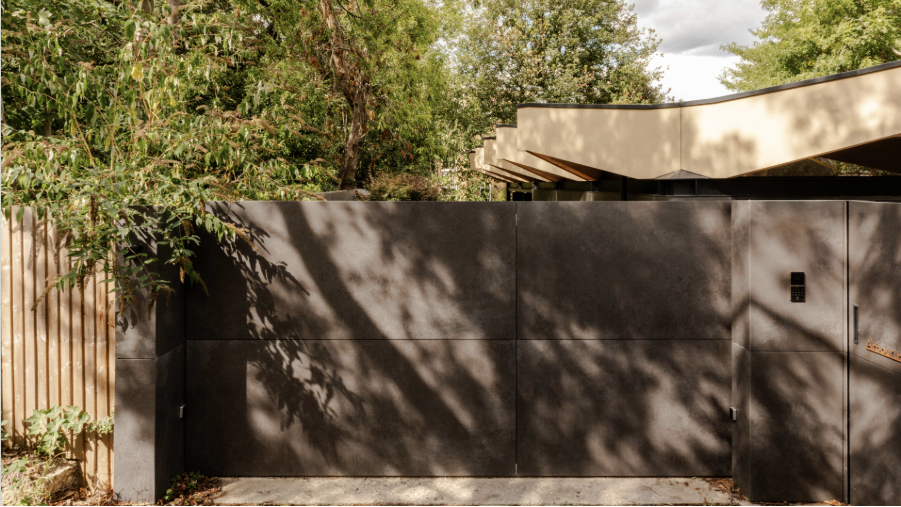London’s brutalist Balfron Tower is brought back to life

Leandro Farina - Photography
Photographed at Studio Egret West’s HQ in Clerkenwell, London, from left to right, Cameron Short, architect, and AB Rogers, founder, AB Rogers Design; Baerbel Schuett, director of development, Londonewcastle; Christophe Egret, co-founder and director, and Brian Mallon, associate director, Studio Egret West; Caroline Radford, development manager, Londonewcastle; Alisan Dockerty, architect, Studio Egret West; Neville Brody, founding director, Brody Associates. An image of Balfron Tower is in the background.
Completed in 1967, the Balfron Tower, as well as the low-rise Carradale House alongside it, remains one of the best-known works of the legendary modernist provocateur Ernö Goldfinger. Located on the northern approach to the Blackwall Tunnel, in London’s Poplar, it’s often seen as the East End’s equivalent of Trellick Tower, and both share a silhouette and certain details. But while the Trellick’s fortunes ebbed and flowed before becoming fashionable quarters, the Balfron never got the same love and attention.
For decades, the bold concrete visions of the 1960s and 1970s were for aficionados only. In recent years, brutalism has been celebrated in crisp black and white photography and rendered in seductive graphics, yet all too often the reality lagged far behind. A chronic lack of maintenance, plus the experimental nature of concrete construction, might have given these rain-streaked monoliths a certain raw edginess, but up close, only the true fetishist could get excited. Finally, though, the rehabilitation is getting structural.
When it came to rebuilding the Balfron, there was undeniable controversy. Opposition from local interest groups focused on how the block’s original quota of affordable housing would be gone for ever. Its sale to a housing association in 2007 was on the understanding that some tenants could choose to stay if they wished while a hefty refurbishment took place. But by 2014, when developer Londonewcastle took on the onerous responsibility of updating the structure, Carradale House was given over to social housing and the Balfron was designated entirely for private sale.

An impression of how an apartment in the revamped Balfron Tower might look. Interiors: Amy Heffernan.
Architects Studio Egret West (SEW) and Ab Rogers Design (ARD) have overseen the update, with Brody Associates creating signage and graphic identity. There’s also a partnership with artist Ryan Gander, who has developed a set of doormats, door numbers and doorbell sounds, all based on original Goldfinger documents.
The Hungarian-born architect’s original design aimed to create self-contained communities in the sky. A separate service tower not only defined the building, but gave residents a place for laundry and hobbies, including a designated ‘jazz/pop’ room. When they came to revamp the building, SEW and ARD began by giving updated functions to the service tower, including a communal kitchen and dining room for events that can’t be held in a two-bedroom flat, together with a workshop, cinema, library, gym and yoga room, as well as a generous communal roof terrace.
While the building has been stripped back to the structure, the basic layout remains, with long service corridors leading to single and two-storey flats. SEW and ARD divided the units up between them, creating open-plan layouts that connect kitchen and living spaces while completely redoing the services and finishes. The palette of materials was painstakingly compiled following research in Goldfinger’s (substantial) archives. One of each of the original six flat typologies will be preserved as carefully recreated ‘heritage’ flats for future generations. The rest of the 140 flats will adopt a more contemporary approach.

The Trellick Tower, 1966-1972, by Ernö Goldfinger is the archetypal symbol of London Brutalism. See more London brutalism here
London’s brutalist classics are now considered as integral to the city’s heritage as the Georgian square or a Christopher Wren church. The Barbican’s Blake Tower, the former YMCA designed by estate architects Chamberlin, Powell and Bon in 1969, is another example of the burgeoning commercial clout of brutalist fetishism. Now repurposed by Conran and Partners as a 17-storey building of 74 private apartments, the concrete provided what project director Simon Kincaid describes as ‘a remarkably rich starting point’.
The architects have left exposed concrete in the apartments, an unthinkable design decision barely a decade ago. Richard Seifert’s Centre Point has also undergone an image-boosting overhaul and recalibration, with its neo-pop brutalist façade containing a clutch of extremely high-end apartments. The nearby Economist Building, designed by brutalist pioneers Alison and Peter Smithson in 1964, is also getting a new lease of life courtesy of DSDHA. Where commerce meets culture, change is inevitably not far behind. Careful design has ensured all these buildings will bring the best of the past into the present.
As originally featured in the July 2018 issue of Wallpaper* (W*232)
INFORMATION
Receive our daily digest of inspiration, escapism and design stories from around the world direct to your inbox.
For more information, visit the Londonewcastle website, the Ab Rogers Design website, the Studio Egret West website, the Brody Associates website, the DSDHA website and the Conran and Partners website
Jonathan Bell has written for Wallpaper* magazine since 1999, covering everything from architecture and transport design to books, tech and graphic design. He is now the magazine’s Transport and Technology Editor. Jonathan has written and edited 15 books, including Concept Car Design, 21st Century House, and The New Modern House. He is also the host of Wallpaper’s first podcast.
-
 A tale of two Audis: the A5 saloon goes up against the A6 Avant e-tron
A tale of two Audis: the A5 saloon goes up against the A6 Avant e-tronIs the sun setting on Audi’s ICE era, or does the company’s e-tron technology still need to improve?
-
 Inside Christian de Portzamparc’s showstopping House of Dior Beijing: ‘sculptural, structural, alive’
Inside Christian de Portzamparc’s showstopping House of Dior Beijing: ‘sculptural, structural, alive’Daven Wu travels to Beijing to discover Dior’s dramatic new store, a vast temple to fashion that translates haute couture into architectural form
-
 A music player for the mindful, Sleevenote shuns streaming in favour of focused listening
A music player for the mindful, Sleevenote shuns streaming in favour of focused listeningDevised by musician Tom Vek, Sleevenote is a new music player that places artist intent and the lost art of record collecting at the forefront of the experience
-
 Arbour House is a north London home that lies low but punches high
Arbour House is a north London home that lies low but punches highArbour House by Andrei Saltykov is a low-lying Crouch End home with a striking roof structure that sets it apart
-
 A former agricultural building is transformed into a minimal rural home by Bindloss Dawes
A former agricultural building is transformed into a minimal rural home by Bindloss DawesZero-carbon design meets adaptive re-use in the Tractor Shed, a stripped-back house in a country village by Somerset architects Bindloss Dawes
-
 RIBA House of the Year 2025 is a ‘rare mixture of sensitivity and boldness’
RIBA House of the Year 2025 is a ‘rare mixture of sensitivity and boldness’Topping the list of seven shortlisted homes, Izat Arundell’s Hebridean self-build – named Caochan na Creige – is announced as the RIBA House of the Year 2025
-
 In addition to brutalist buildings, Alison Smithson designed some of the most creative Christmas cards we've seen
In addition to brutalist buildings, Alison Smithson designed some of the most creative Christmas cards we've seenThe architect’s collection of season’s greetings is on show at the Roca London Gallery, just in time for the holidays
-
 In South Wales, a remote coastal farmhouse flaunts its modern revamp, primed for hosting
In South Wales, a remote coastal farmhouse flaunts its modern revamp, primed for hostingA farmhouse perched on the Gower Peninsula, Delfyd Farm reveals its ground-floor refresh by architecture studio Rural Office, which created a cosy home with breathtaking views
-
 A revived public space in Aberdeen is named Scotland’s building of the year
A revived public space in Aberdeen is named Scotland’s building of the yearAberdeen's Union Terrace Gardens by Stallan-Brand Architecture + Design and LDA Design wins the 2025 Andrew Doolan Best Building in Scotland Award
-
 The Architecture Edit: Wallpaper’s houses of the month
The Architecture Edit: Wallpaper’s houses of the monthFrom wineries-turned-music studios to fire-resistant holiday homes, these are the properties that have most impressed the Wallpaper* editors this month
-
 A refreshed 1950s apartment in East London allows for moments of discovery
A refreshed 1950s apartment in East London allows for moments of discoveryWith this 1950s apartment redesign, London-based architects Studio Naama wanted to create a residence which reflects the fun and individual nature of the clients